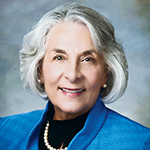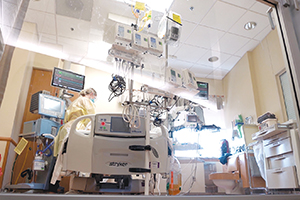By JULIE MINDA
The chief factor limiting health care facilities' ability to respond to surging COVID-19 patient counts is the shortage of frontline staff for the departments that treat seriously ill patients.
A sampling of ministry leaders say they are exploring both short-term fixes and long-term solutions to staffing challenges that predate the pandemic.

Hunt
Linda Hunt is president and chief executive of the Southwest Division of Dignity Health, part of CommonSpirit Health. She is quoted in a COVID update press release issued Sept. 1 by the Arizona Department of Health Services saying, "This latest COVID-19 surge has been challenging for health care workers. They are exhausted yet continue to step up in the most heroic ways. The high volume of patients compounded by the shortage of doctors and nurses across the country is creating intense competition for a limited pool of nurses nationwide."
Similar shortages exist for other clinician groups including respiratory therapists and certified nursing assistants, ministry leaders said.
Disrupted pipeline
Several ministry leaders said many health care workers left the field during the pandemic. Some retired early and some quit, worn down by understaffing and the relentless influx of patients. Others stepped away because they feared bringing the virus home, or had child care issues when schools and day care providers closed.

Nurse Brennen Magagna treats an ICU patient at Saint Alphonsus Regional Medical Center in Boise, Idaho, on Sept. 9. Weeks earlier, the hospital's chief clinical officer, Dr. Steven Nemerson, called the COVID surge, "The worst we've seen."
Many health care staff have been sidelined temporarily at different times over the past 20-plus months by COVID exposures or infections and related quarantines, further complicating staffing.
Additionally, the pipeline of new health care job candidates was interrupted when the pandemic closed down or curtailed operations of nursing schools and other clinical education programs. The pool of new graduates contracted as a result.
Shifting locales, roles
Ministry systems and facilities have been handling the shortages in many ways. Large systems including Ascension are sharing staff among their facilities, with nurses and other frontline providers sometimes traveling across state lines to aid sister hospitals. However, according to information from Ascension Wisconsin, this was much easier to do when outpatient facilities were temporarily closed at the start of the pandemic, and those clinicians were free to take temporary assignments in acute care sites. With outpatient sites open now, the bench isn't so deep.
CommonSpirit Health's Marian Regional Medical Center in Santa Maria, California, is among hospitals that have been cross-training nurses to work in other departments. It is actively prospecting matriculating nursing school students — they are in short supply. It is hiring nursing students for jobs they are qualified to take at the hospital so that the facility will have a leg up in recruiting once the students are licensed nurses.
Extra hands
In late August, multiple Providence St. Joseph Health hospitals in Western Oregon welcomed Oregon National Guard personnel, who trained to aid with COVID patient care support, including safely repositioning frail patients. Jennifer Burrows, chief executive of Portland's Providence St. Vincent Medical Center and of Providence St. Joseph Health's Western Oregon region, said the guard brought much needed fresh enthusiasm and energy to the hospitals.
PeaceHealth Sacred Heart Medical Center at RiverBend in Oregon and other PeaceHealth sites also accepted National Guard aid. In late August and throughout September, the guard helped with data entry, clerical work, food tray delivery, bed cleaning, supply chain and other tasks, to support overwhelmed hospital staff.
Two Saint Alphonsus Health System hospitals in Oregon added a total of 13 National Guard to their staff. The system's hospitals in Idaho got 64 state-allocated contract workers through Federal Emergency Management Agency funding.
CommonSpirit Health's CHI Memorial in Chattanooga, Tennessee, in early September welcomed nine men and women from the Tennessee Air and Army National Guard to work in the hospital's monoclonal antibody injection clinic. The group was to provide administrative and clinical support in the clinic for at least two weeks.
In early August, Louisiana's Our Lady of the Lake Regional Medical Center accepted the assistance of a 33-member Disaster Medical Assistance Team from the U.S. Department of Health and Human Services to lighten the load on strained hospital staff members. The HHS team, which included physicians, midlevel providers, nurses, paramedics, a respiratory therapist, pharmacists and administrative support specialists, provided assistance to COVID units at the hospital and helped with admissions. This team also enabled the hospital to open an additional intensive care unit.
The HHS team has been replaced by a medical team provided by the U.S. Department of Defense.
Dollars and cents
Providence St. Joseph Health is addressing the staffing challenge from a system level in part through a $220 million fund announced in early September. The money will cover a $1,000 "recognition bonus" for its 120,000 associates. It also will enable the system to recruit to rapidly fill 17,000 job openings at Providence sites. The system will use some of the dollars for referral bonuses for employees who recruit job candidates for vacancies.
Some hospitals will get help from new state funding initiatives. For example, the Idaho Department of Health and Welfare has announced hospitals can apply for funding of $1,000 per licensed bed to shore up staffing. And the Arizona Department of Health Services is allotting $60 million to health care facilities in the state, primarily to address staffing problems.
Competitive pressures
Jerry Carley is president and chief executive of the Benedictine long-term care system, which operates primarily in the Upper Midwest. In the regions Benedictine serves, hospitals are rapidly raising staff pay to address workforce shortages. But long-term care sites do not have the same access to capital to keep their pay scales competitive and are losing staff to acute care facilities, Carley said. The problem has become so severe that sometimes hospitals are unable to discharge patients to nursing homes for short-term rehab because the nursing homes do not have the staff to care for them.
Carley said that in his three decades in long-term care, "I've never seen staffing issues like this."